Power-to-weight ratio is a calculation commonly applied to engines and mobile power sources to enable the comparison of one unit or design to another. Power-to-weight ratio is a measurement of actual performance of any engine or power source. It is also used as a measurement of performance of a vehicle as a whole, with the engine's power output being divided by the weight of the vehicle, to give a metric that is independent of the vehicle's size. Power-to-weight is often quoted by manufacturers at the peak value, but the actual value may vary in use and variations will affect performance.

The Subaru Impreza is a compact car that has been manufactured by the Japanese automaker Subaru since 1992. It was introduced as a replacement for the Leone, with the predecessor's EA series engines replaced by the new EJ series. It is now in its sixth generation.
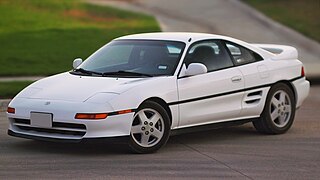
The Toyota MR2 is a line of two-seat, mid-engined, rear-wheel-drive sports cars manufactured in Japan and marketed globally by Toyota from 1984 until 2007 over three generations: W10 (1984–1989), W20 (1989–1999) and W30 (1999–2007). It is Japan's first rear mid-engined production car.
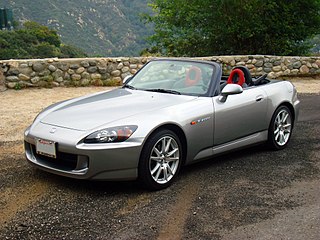
The Honda S2000 is a front-mid engine open top sports car that was manufactured by Japanese automobile manufacturer Honda, from 1999 until 2009. First shown as a concept car called the SSM at the Tokyo Motor Show in 1995, the production version was launched on April 15, 1999, to celebrate the company's 50th anniversary. The S2000 is named for its engine displacement of two litres, while "S" stood for "sports" carrying on in the tradition of the S500, S600, and S800 roadsters of the 1960s.

The BMW M3 is a high-performance version of the BMW 3 Series, developed by BMW's in-house motorsport division, BMW M GmbH. M3 models have been produced for every generation of 3 Series since the E30 M3 was introduced in 1986.

The Suzuki GSX1300R Hayabusa is a sports motorcycle made by Suzuki since 1999. It immediately won acclaim as the world's fastest production motorcycle, with a top speed of 303 to 312 km/h.

The Saleen S7 is an American hand-built, high-performance sports car designed and built by American automobile manufacturer Saleen Automotive Inc. Developed jointly by Steve Saleen for the initial concept, direction and engine, Hidden Creek Industries for resources and initial funding, Ray Mallock Ltd. (RML) for chassis, suspension and aerodynamics, and Phil Frank for the body and interior CAD design and development.

The Porsche 908 was a racing car from Porsche, introduced in 1968 to continue the Porsche 906-Porsche 910-Porsche 907 series of models designed by Helmuth Bott (chassis) and Hans Mezger (engine) under the leadership of racing chief Ferdinand Piëch.

The Volvo Modular Engine is a family of straight-four, straight-five, and straight-six automobile piston engines that was produced by Volvo Cars in Skövde, Sweden from 1990 until 2016. All engines feature an aluminum engine block and aluminum cylinder head, forged steel connecting rods, aluminum pistons and double overhead camshafts.

The Porsche 911 GT2 is a high-performance, track-focused sports car built by the German automobile manufacturer Porsche from 1993 to 2009, and then since 2010 as the GT2 RS. It is based on the 911 Turbo, and uses a similar twin-turbocharged engine, but features numerous upgrades, including engine enhancements, larger brakes, and stiffer suspension calibration. The GT2 is significantly lighter than the Turbo due to its use of rear-wheel-drive instead of all-wheel-drive system and the reduction or removal of interior components. As a result, the GT2 is the most expensive and fastest model among the 911 lineup.

A bike-engined car is a small or light weight car that is powered by an engine that was designed for use in a motorcycle.

The sixth generation of the Ford Taurus is the final generation of the model range manufactured by Ford. Introduced for the 2010 model year, the sixth-generation Taurus is the second generation of the model line produced as a full-size car; it was the heaviest sedan sold under the Ford brand worldwide. While sharing its D3 chassis underpinnings with the previous generation, the sixth generation marked the first North American use of Kinetic Design design language.

EcoBoost is a series of turbocharged, direct-injection gasoline engines produced by Ford and originally co-developed by FEV Inc.. EcoBoost engines are designed to deliver power and torque consistent with those of larger-displacement naturally aspirated engines, while achieving about 30% better fuel efficiency and 15% fewer greenhouse emissions, according to Ford. The manufacturer sees the EcoBoost technology as less costly and more versatile than further developing or expanding the use of hybrid and diesel engine technologies. EcoBoost engines are broadly available across the Ford vehicle lineup.

Lotec is a German sports car manufacturer. The company was founded in 1962 by Kurt Lotterschmid. By 1969, the firm began building race cars, and would turn their attention to modifications for Porsches in 1975. In 1983, they began to create aftermarket aerodynamic and performance parts for Mercedes-Benz cars and Ferrari cars.
Within motorsport, the RMR Hyundai Genesis PM580 is a LeMans-style race car built by Rhys Millen Racing (RMR) racing to compete in the 2010 Pikes Peak International Hillclimb Unlimited class and designed to break the 2007 record time of 10:01.408 minutes set by Nobuhiro Tajima's in a Suzuki XL7 Hill Climb Special.

The Infiniti Q50 is a compact executive car manufactured by Nissan for its luxury brand, Infiniti. Replacing the G/Q40 sedan, it debuted at the 2013 North American International Auto Show and went on sale in North America in the third quarter 2013 and in Europe in fourth quarter 2013. It is the export model of the Japanese domestic market's V37 Nissan Skyline.
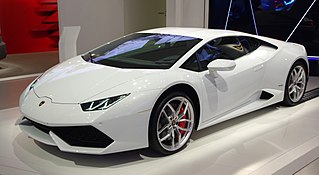
The Lamborghini Huracán is a sports car manufactured by Italian automotive manufacturer Lamborghini replacing the previous V10 offering, the Gallardo. The Huracán was revealed online in December 2013, making its worldwide debut at the 2014 Geneva Auto Show, and was released in the market in the second quarter of 2014.

The Volvo Engine Architecture (VEA) is a family of straight-three and straight-four automobile petrol and diesel engines produced by Volvo Cars in Skövde, Sweden, since 2013, Zhangjiakou, China since 2016 and Tanjung Malim, Malaysia since 2022 by Proton. Volvo markets all engines under the Drive–E designation, while Geely groups the three-cylinder variants with its other engines under the G-power name. These engines are some of the few ever put into production as twincharged engines, in the company of the Lancia Delta Integrale and concept Jaguar CX-75.
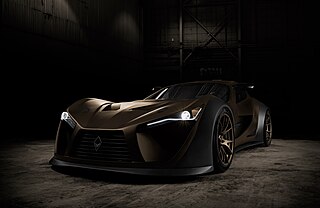
The Felino cB7 is a Canadian sports car produced by automotive company FELINO Cars. The car was in development for a total of seven years before its official production in 2016.
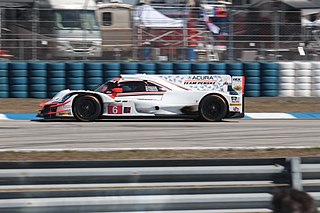
A Daytona Prototype International (DPi) was a type of sports prototype racing car developed specifically for the International Motor Sports Association's WeatherTech SportsCar Championship, as their top class of car, acting as a direct replacement, and spiritual successor of the Daytona Prototypes. They are named after the main series event, the Rolex 24 at Daytona. The class made its racing debut at the 2017 24 Hours of Daytona.


















